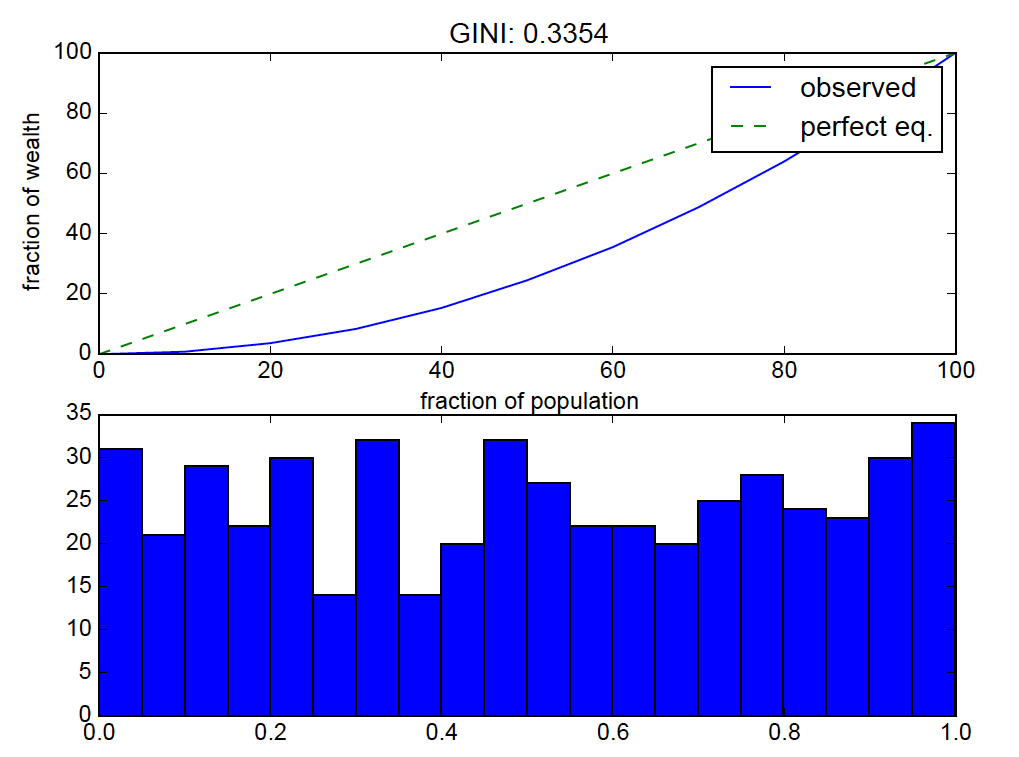我正在计算 Gini coefficient (类似于:Python - Gini coefficient calculation using Numpy)但我得到一个奇怪的结果。对于从 np.random.rand() 采样的均匀分布,基尼系数为 0.3,但我预计它会接近 0(完全相等)。这里出了什么问题?
def G(v):
bins = np.linspace(0., 100., 11)
total = float(np.sum(v))
yvals = []
for b in bins:
bin_vals = v[v <= np.percentile(v, b)]
bin_fraction = (np.sum(bin_vals) / total) * 100.0
yvals.append(bin_fraction)
# perfect equality area
pe_area = np.trapz(bins, x=bins)
# lorenz area
lorenz_area = np.trapz(yvals, x=bins)
gini_val = (pe_area - lorenz_area) / float(pe_area)
return bins, yvals, gini_val
v = np.random.rand(500)
bins, result, gini_val = G(v)
plt.figure()
plt.subplot(2, 1, 1)
plt.plot(bins, result, label="observed")
plt.plot(bins, bins, '--', label="perfect eq.")
plt.xlabel("fraction of population")
plt.ylabel("fraction of wealth")
plt.title("GINI: %.4f" %(gini_val))
plt.legend()
plt.subplot(2, 1, 2)
plt.hist(v, bins=20)
对于给定的一组数字,上述代码计算每个百分位区间中总分布值的分数。
结果:
均匀分布应该接近“完全相等”,所以洛伦兹曲线弯曲是关闭的。
最佳答案
这是意料之中的。来自均匀分布的随机样本不会产生均匀值(即彼此相对接近的值)。稍加微积分,可以证明在 [0, 1] 上均匀分布的样本基尼系数的期望值(统计意义上的)是 1/3,因此得到对于给定样本,大约 1/3 的值是合理的。
使用 v = 10 + np.random.rand(500) 等样本,您将获得较低的基尼系数。这些值都接近 10.5; 相对 变化低于样本 v = np.random.rand(500)。
事实上,样本base + np.random.rand(n)的基尼系数期望值为1/(6*base + 3)。
下面是基尼系数的简单实现。它使用基尼系数是 relative mean absolute difference 的一半这一事实.
def gini(x):
# (Warning: This is a concise implementation, but it is O(n**2)
# in time and memory, where n = len(x). *Don't* pass in huge
# samples!)
# Mean absolute difference
mad = np.abs(np.subtract.outer(x, x)).mean()
# Relative mean absolute difference
rmad = mad/np.mean(x)
# Gini coefficient
g = 0.5 * rmad
return g
(有关更高效的实现,请参阅 More efficient weighted Gini coefficient in Python)
这是 v = base + np.random.rand(500) 形式的几个样本的基尼系数:
In [80]: v = np.random.rand(500)
In [81]: gini(v)
Out[81]: 0.32760618249832563
In [82]: v = 1 + np.random.rand(500)
In [83]: gini(v)
Out[83]: 0.11121487509454202
In [84]: v = 10 + np.random.rand(500)
In [85]: gini(v)
Out[85]: 0.01567937753659053
In [86]: v = 100 + np.random.rand(500)
In [87]: gini(v)
Out[87]: 0.0016594595244509495
关于python - 在 Python/numpy 中计算基尼系数,我们在Stack Overflow上找到一个类似的问题: https://stackoverflow.com/questions/39512260/
